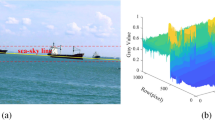Abstract
Sea wave extraction is the foundation of sea wave measurement, which plays a significant role in binocular stereo vision-based tsunami early-warning systems. However, long-distance sea surface images possess two typical features: ununiformed illuminance and a low signal-to-noise ratio that makes it difficult to extract sea waves out from sea surface images and that leads to incorrect extractions. In this paper, we improved the Otsu algorithm to realize a dynamic multi-threshold algorithm for sea wave extraction. First, the original image was divided into small blocks and the dynamic multi-thresholds were determined according to local sea surface illuminance. Then an evaluation function was defined to add constraint conditions to adjacent blocks’ thresholds. Finally, sea waves were extracted out using the blocks’ thresholds in all the blocks. As seen in our experimental results, the correct extraction rate was 80.9%, most sea waves are extracted regardless of their intensity.













Similar content being viewed by others
References
Barrientos SE, Ward SN (1990) The 1960 Chile earthquake: inversion for slip distribution from surface deformation. Geophys J Int 103(3):589–598
Suzuki W, Aoi S, Sekiguchi H, Kunugi T (2012) Source rupture process of the 2011 Tohoku-Oki earthquake derived from strong-motion records. In: Proceedings of the fifteenth world conference on earthquake engineering. Lisbon, Portugal
BBC NEWS. Indonesia quake toll jumps again. http://news.bbc.co.uk/2/hi/asia-pacific/4204385.stm. Accessed 25 Jan 2005
Japan Meteorological Agency. Observation and Monitoring System of Earthquake and Tsunami http://www.data.jma.go.jp/svd/eqev/data/monitor/index.html. Accessed 11 Jan 2018
Japan Meteorological Agency. Prediction of Tsunami. http://www.data.jma.go.jp/svd/eqev/data/tsunami/ryoteki.html. Accessed 11 Jan 2018
Christian M, Scott ES, Alex IN, Frank G (2005) Technology developments in real-time tsunami measuring monitoring and forecasting. In: Proceedings of OCEANS 2005MTS/IEEE, Washington, DC, USA, 17–23 Sept. 2005, 0197-7385
Yu K (2015) Tsunami-wave parameter estimation using gnss-based sea surface height measurement. IEEE Trans Geosci Remote Sens 53(5): 2603–2611
Benjamin DH, Oleg AG, Vladimir GI, Robert RL (2011) Detection of tsunamis from changes in ocean surface roughness. Tsunami Threat Res Technol. https://doi.org/10.5772/13979
Lambin J, Lognonné P, Occhipinti G, Murakami M (2005) Tsunami detection in the ionosphere. Cospar Inform Bull. https://doi.org/10.1016/S0045-8732(05)80048-8
Ma J, Hickey M, Komjathy A (2015) Ionospheric electron density perturbations driven by seismic tsunami-excited gravity waves: effect of dynamo electric field. J Mar Sci Eng 3:1194. https://doi.org/10.3390/jmse3041194
Cai Y, Lu C, Yan L, Tsujino K (2017) Cooperative control of dual camera rotation using angle feedback. In: Proceedings of the 2017 IEICE general conference, Nagoya, Japan, Mar 22–25, 2017, D-11-42
Yin G (2007) Image segmentation based on threshold. Xi’an Electronic and Science University, Xi’an
Lindeberg T (1998) Edge detection and ridge detection with automatic scale selection. Int J Comput Vision 30(2):117–154
Adams R, Bischof L (1994) Seeded region growing. IEEE Trans Pattern Anal Mach Intell 16(6):641–647
Otsu N (1979) A threshold selection method from gray level histograms. IEEE Trans Syst Man Cyber 9(1):62–66
Author information
Authors and Affiliations
Corresponding author
Additional information
Publisher’s Note
Springer Nature remains neutral with regard to jurisdictional claims in published maps and institutional affiliations.
About this article
Cite this article
Yang, Y., Lu, C. Long-distance sea wave extraction method based on improved Otsu algorithm. Artif Life Robotics 24, 304–311 (2019). https://doi.org/10.1007/s10015-018-0516-0
Received:
Accepted:
Published:
Issue Date:
DOI: https://doi.org/10.1007/s10015-018-0516-0




